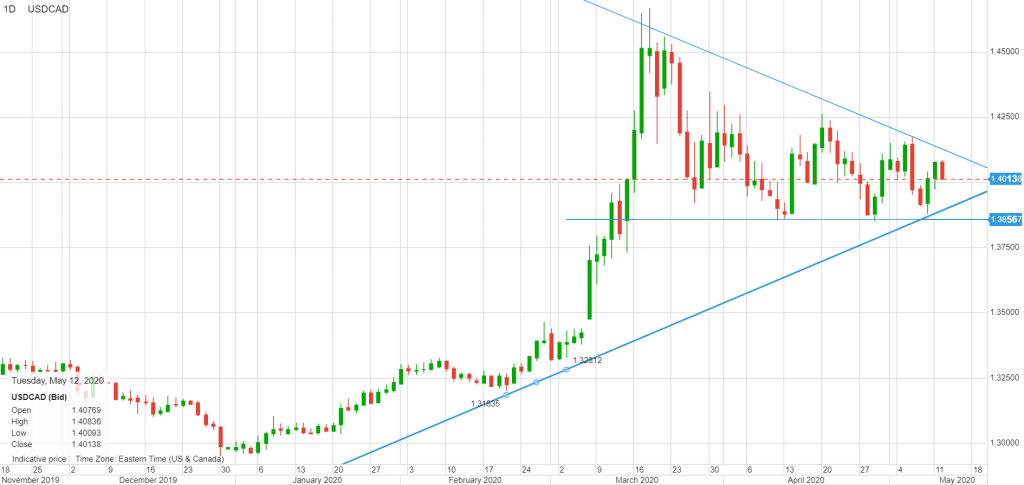
May 13, 2020
USDCAD open (6:00 am EST) 1.4031-35 Overnight Range 1.4009-1.4084
- Trump promotes negative interest rates-RBNZ was listening
- Fed Chair Powell view on negative rates may be heard today at 9:00 am EDT
- GBPUSD ignores data and recoups some of yesterdays losses
- NZD is worst performing currency overnight as US dollar opens mixed in NY
Percent change in Currency value against US dollar, Monday NY open to Friday NY open (6:00 am EDT)

Source: Saxo Bank/IFXA
FX Recap and outlook: President Trump put his central banker hat on and opined about US interest rates yesterday. He tweeted “As long as other countries are receiving the benefits of Negative Rates, the USA should also accept the “GIFT”. Big numbers! The comment sparked a sell-off on Wall Street, exacerbated a slide in US Treasury yields, and knocked FX markets into risk aversion mode.
Wall Street may have been further spooked by comments from whiz-bang, former hedge fund super-star, Stanley Druckenmiller, who said the risk-reward for equities is the worst he has ever seen and that a V-shaped recovery was a fantasy.
Neither St Louis Fed President James Bullard or Chicago Fed President Charles Evans agrees with Trump’s interest rate view, and Fed Chair Jerome Powell will likely be singing from the same song sheet today.
EURUSD retreated after Trump’s comments yesterday and consolidated in a 1.0832-1.0856 range overnight, which is well above Tuesday’s low. The single currency may be seeing a bit of safe-haven demand, despite the legal spat between Germany’s High Court and the European Court of Justice (ECJ). The German court told the ECJ “it shouldn’t consider itself master of the universe.” Weak March Industrial Production data was ignored.
GBPUSD is suffering from a litany of woes including the risk of negative interest rates, concerns around the EU/UK trade talks, a slew of weak economic data, and bearish technicals. Yesterday, Bank of England Deputy Governor Ben Broadbent suggested it was “quite possible” for additional easing measures, which with the BoE overnight rate at 0.1%, suggests negative rates. March GDP fell 5.8%. The intraday GBPUSD technicals suggest that the break below 1.2335 on Monday opens the door to further losses to 1.2000.
President Trump put his central banker hat on and opined about US interest rates yesterday.
USDJPY is retracing Monday’s gains with a break below 106.90 suggesting further losses to 106.20. Prices are weighed down by the drop in 10-year Treasury yields to 0.66% from 0.72% and caution ahead of Fed Chair Powell’s speech.
The Reserve Bank of New Zealand put the cat among the pigeons when they opened the door to lower interest rates, which raised the spectre of negative rates.
They left the benchmark OCR rate unchanged and doubled their QE program. NZDUSD plunged to 0.6000 from 0.6095. AUDUSD outperformed its antipodean cousin and managed to squeeze out a tiny gain against the US dollar, compared to Tuesday’s close.
WTI oil prices are directionless in a $25.00-$26.00/barrel range. Prices were underpinned by the API report showing US crude stock increased less than the price week, and by news that Iran was cutting back shipments to Asia. Concern about a second coronavirus outbreak capped gains.
USDCAD tracked broad US dollar sentiment and gave back about half of yesterday’s gains in Europe. Traders ignored news that Norway blacklisted 4 Canadian oil companies from its $1 trillion wealth fund.
This morning, the US Producer Price Index was -1.3%, below forecasts for a 0.5% decline. It was ignored, and the US dollar continued to retreat in NY trading, support by S&P futures which are in positive territory.
USDCAD technical outlook
The daily USDCAD chart continues to show a series of lower highs and downtrend while prices are below 1.4120. A break above 1.4120 suggests additional gains to 1.4280 and then 1.4660. A break below 1.3860 suggests a drop to 1.3060. For today, USDCAD support is at 1.4005 and 1.3950. Resistance is at 1.4080and 1.4120. Today’s Range 1.3960-1.4060
Chart: USDCAD daily

Source: Saxo Bank





